Sailing Ship Rigs
The sail plans of sailing vessels were many and varied. Beside differences in original design, a ship might undergo a number of changes, depending upon the whims of her owner, captain, or builder, the trade she was used in, or local traditions. These changes were introduced to improve sailing qualities and to provide a rig that could be handled by a smaller crew, th us paying higher returns to shareholders.
us paying higher returns to shareholders.
 The silhouettes of vessels overleaf represent different rigs of ships on the east coast of North America during the mid 1800s to the early 1900s, a period in marine history often referred to as the "golden age of sail".
The silhouettes of vessels overleaf represent different rigs of ships on the east coast of North America during the mid 1800s to the early 1900s, a period in marine history often referred to as the "golden age of sail".
Sailing ship rigs can be divided into two broad categories: the "fore and aft rig" (left), in which the sails lie along the same plane as the ship's fore and aft line; and the "square rig" (right), in which the sails are rigged athwart (across) the ship. Each rig had certain advantages.
The Fore & Aft Rig
The fore and aft rig, or schooner rig, required only a small crew, and was generally used in the coastal and fishing trades. Ships with this rig could point higher into the wind and were usually more maneuverable when working in the changing winds along the coast. The rig was not limited to coastal schooners, and big fore-and-afters could be seen plying across the Western Ocean bound for European ports, the West Indies, or South America.
Sloop
A fore and aft rigged vessel with one mast is a sloop. In the early 1800s some large sloops traded with the West Indies, but most sloops in the 19th century were small inshore fishing vessels. In the 20th century, sloops became the most popular rig for yachts.
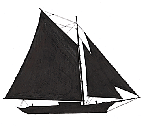
Grand Bank Fishing Schooner
Schooners have two or more masts with fore and aft sails. Similar to the famous Bluenose, our example, in addition to all the normal lower sails, carries a main gaff topsail and a fisherman's staysail set between the masts.
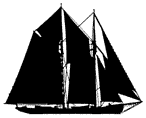
Two Masted Fishing Schooner
Two Masted Fishing Schooner in winter rig. Her topmast and all light upper canvas have been struck, and sent ashore.

Square Topsail Schooner
Square Topsail Schooner a combination of fore and aft sails and small square sails. They were popular for coastal trading in the early 1800s. Prince Edward Island built a number of topsail schooners and many were sold in Great Britian. A version with raked masts, called the Baltimore Clipper, was much favoured by privateersmen in the War of 1812.

Coastal Schooner
Coastal Schooner, the work horse of our coastal trade. She was probably not much more than a hundred tons, and carried everything from timber and coal to bricks, general cargo, and a load of hay to offshore island communities. Our schooner is shown with only a main topmast, but many also carried a fore topmast. Note the yawl boat towing astern.
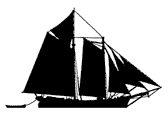
Four Masted Schooner
Four Masted Schooner shown at anchor. This design attempted to reduce individual sail area, raise tonnage, and still manage with a small crew. In the early days sails were hoisted by hand, but gradually the gasoline hoisting engine was introduced, saving work, wages, and food. She could operate with eight hands, and reached 500 to 700 tons. At the turn of the century these schooners were used in the coastal trade between Canada and the United States, the West Indies, South America, and some trans-Atlantic voyages were made to Europe and West Africa. Nova Scotians built and operated between seven and eight hundred big schooners, but by World War I most had passed out of the picture. Along the New England coast a number of five and six masted schooners were built, plus one seven master, the steel hulled Thomas W. Lawson.
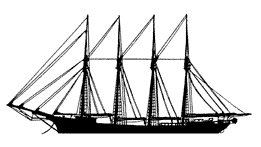
Tern Schooner
Tern Schooner a three master built in great numbers all along our shores between 1880 and 1920. These vessels were cargo carriers of between 200 and 400 tons, requiring a crew of six to eight. Our Tern is shown with all sails set except staysails between the masts. As the years went by these softwood vessels would become waterlogged, sails would wear out, and spars break. With the inroads made by the steamer, the old schooners were hard pressed to find a cargo. A few did survive until World War II.
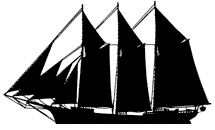
The Square Rig
The square rig was normally an offshore rig used by vessels making long ocean passages and taking advantage of the prevailing wind and current patterns of the globe. These ships varied in size from the small handy brigantines and brigs of a couple of hundred tons to the great full rigged ships and barques of over two thousand tons. The square rig was also seen in the coastal trade, where brigs plied their trade up and down the eastern seaboard.
Brigantine
Brigantine, a two masted vessel square rigged on the foremast, with fore-and-aft sails on the mainmast. The drawing shows a typical Bluenose softwood vessel of about 220 tons, similar to the Spencers Island built Amazon which later became the famous mystery ship Mary Celeste. The brigantine is shown with two staysails set between the masts.
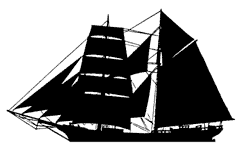
Brig
Brig, a two masted vessel square rigged on both masts. The brig is a very old and efficient sailing rig, and the class was still in use up to the very end of commercial sailing ships. Only a few brigs were built in Nova Scotia yards, but they were very common in European waters.

Barquentine
Barquentine, a vessel with the foremast rigged square, and the other masts rigged fore and aft. Our vessel is similar to the Maid of England of 750 tons built at Grosses Coques in 1919. She was the last Canadian commercial vessel to carry a square rig, being abandoned at sea in 1928. Only a small number of this type were built locally.
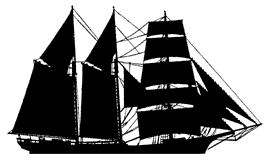
Barque or Bark
Barque or Bark , usually a three masted vessel, the fore and main masts square rigged and the mizzen mast or after mast rigged fore and aft. The four masted barque was a relatively common rig on the oceans, but only two were built in Canada. The John M. Blaikie was launched in 1885 at Great Village, and the Kings County launched in 1890 at Kingsport. The barque was a popular rig, and more of this type were built than all other square rigs combined. The big Maitland barque Calburga was the last British North American square rigger of large tonnage to be on the Canadian registry; she was lost off the coast of Wales in November 1915.

Full Rigged Ship
Full Rigged Ship, square rigged on all masts. Staysails could be set between the masts. Outboard of the square sails might be set studdingsails, and above the royals (uppermost sails) might be set sails with such names as skysail, moonraker, Trust to God, or Angel Whispers. The ship William D. Lawrence, built at Maitland N.S. in 1874, was the largest wooden sailing ship ever built in Canada. Towards the end of their careers some ships were reduced to barque rig. Many were "sold foreign" and many others simply were "lost without trace" or abandoned at sea.
Within the decade of the 1890s and the early 20th century the disappearance of the British North American square rigger was swift. Iron, steel and steam, plus high insurance rates and low freights caused most owners to dispose of their fleets. For some years they tramped the oceans of the world under foreign flags, until finally giving up.
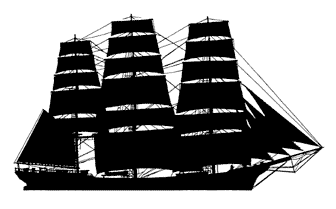
They built 'em in Annapolis, Windsor, River John
Jest as able packets as you ever shipped upon.
Yarmouth ships, Maitland ships, hookers from Maccan.
The kind 'o craft that took the eye of any sailorman
Them fine old wind bags - them Nova Scotiamen!
Text and silhouettes by Graham McBride.
